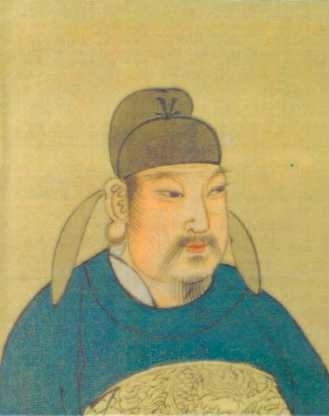
Image Source: Public Domain
About Emperor Xu?nzong
Reign Years:846- 859 A.D
Given Name: Li Chen
Reign Name:Emperor Xuanzong of the 9th Century

Image Source: Public Domain
Reign Years:846- 859 A.D
Given Name: Li Chen
Reign Name:Emperor Xuanzong of the 9th Century
Xuanzong of Tang was an emperor who ruled during the latter part of Chinas Tang Dynasty. His personal name was Li Yi, which was later changed to Li Chen. Before ruling as the Tang Dynasty emperor, he was known as the Prince of Guang.
Emperor Xuanzong was considered the last capable emperor of the Tang Dynasty. The rulers who succeeded the throne after him were either too young or were dominated by eunuchs and warlords.
Go back in time and follow the timeline and emperors of the Tang Dynasty.
Read MoreLi Yi was born in 810 at the Daming Palace. He was the thirteenth son among Emperor Xianzongs twenty sons. His mother was Consort Zheng, one of Xianzongs concubines.
After Emperor Xianzongs death in 820, Li Heng, Li Yis older brother, succeeded the throne as Emperor Muzong. In the next year, Muzong made some of his sons and brothers imperial princes. This time, Li Yi was named the Prince of Guang.
In early 846, Emperor Wuzong became severely ill. The eunuchs then decided to make Li Yi the thrones successor since they thought he was easier to manipulate. With that, the eunuchs made an edict under Emperor Wuzongs name, naming Li Yi as crown prince.
His personal name was changed to Li Chen, and he was designated to be in charge of imperial affairs. With Li Chens actions on pending matters, people started seeing him as intelligent and capable.
Soon after, Emperor Wuzong died, and Li Chen seized the throne as Emperor Xuanzong.
Xuanzong of Tang was born in an era where there were a lot of palace intrigues and schemes among officials. Once he ascended the throne, he started various reforms to restore the faltering dynasty.
After succeeding the throne, Emperor Xuanzong opposed the powerful chancellor Li Deyu, who dominated the court when Emperor Wuzong ruled. Xuanzong wasnt in favor of Li Deyu for monopolizing power, so he removed the chancellor from his position.
After that, he sent him out of the capital to serve as Jingnan Circuits military governor. Aside from Li Deyu, Emperor Xuanzong also removed another chancellor named Zheng Su from his position.
In the next few years, the Tang Dynasty emperor expelled officials that he considered to favor Li Deyu. Xuanzong further pressed charges against Li Deyu since the former chancellor executed Wu Xiang, a minor official. The latter was killed, even if his charges shouldnt have a warranted death.
Xuanzong of Tang repeatedly demoted Li Deyu and sent him farther away from Changan. The expelled chancellor eventually died in exile around 850 in the Yai Prefecture.
Emperor Xuanzong contributed to various cultural and technological advancements during his rule. He reversed numerous policies from the previous rule, like the alliance with the Yenisei Kirghiz and Buddhist persecution. The Tang Dynasty emperor also installed Bai Minzhong as the leading chancellor to replace Li Deyu.
Additionally, the emperor paid attention to the Tibetan empire. By 848, Xuanzong ordered missioned border troops to reclaim the prefectures lost to the Tibetan empire since the Anshi Rebellion.
Zhang Yuchao, an ethnic Han Chinese, seized the Hexi Corridor from Tibetan officials. He then submitted to Xuanzong of Tang in 851. As a result, the Tang empire regained a lot of its losses from the Tibetan empire.
However, he barely had any success with the Tangut rebels.
After realizing that these people were rebelling due to the Tang officials mistreatment, the Tang Dynasty emperor modified policies. He installed officials who had good temper and were honest with their jobs. Thats when he set Bai to handle the operations against the rebel Tanguts.
With Bai overseeing the situation, the Tanguts eventually submitted in 851. However, Bai didnt return to his chancellor position during Xuanzongs lifetime. Instead, he was replaced by Linghu Tao.
The Tang Dynasty emperor was said to be a diligent ruler who encouraged frugality. It was also claimed that throughout his rule, the imperial family members all carefully and honestly obeyed the rules.
This rare celadon jar from the ancient Song Dynasty features a beautiful all-olive green design, smooth and shiny, with a firm base from which grows an asymmetrically oval body with elegant grooved borders to a modest, slightly raised rim.
Buy Now!This rare preserved Song Dynasty celadon plate has a design devoid of decoration that makes it look like a beautiful, untouched piece of jade. Its bottom rests on a base that grows in layers around a small foot that grows along fine grooved borders.
Buy Now!This rare Song Dynasty ewer possesses an irresistible natural charm that exudes simplicity and grace in every part. It has an uncluttered base with a small foot that gives rise to a firm, sturdy body, devoid of any more decoration than a simple protruding medallion.
Buy Now!Late in the reign of Emperor Xuanzong, he somewhat ended up favoring a few alchemists who promised him immortality. Because of this, he took all the pills that they created for him. As a result of ingesting these pills, the Tang Dynasty emperor became paranoid and was easily angered.
By 859, one side effect of the pills greatly affected the ruler. He acquired a huge ulcerous boil on his back which left him bedridden. It also prevented him from meeting with the empires chancellors and other officials.
In 859, Emperor Xuanzong died at the age of fifty.
The success of his rule was compared to that of his most prominent predecessors, Taizong. Despite his accomplishments, the succeeding Tang rulers werent able to revive the dynasty. Then, it immediately fell in disarray as political issues and intrigues continued.
Join the VIP club, Get Auction notification, special offers and more!